玩转数据结构 第4章 最基础的动态数据结构:链表
4-1 什么是链表
线性数据结构
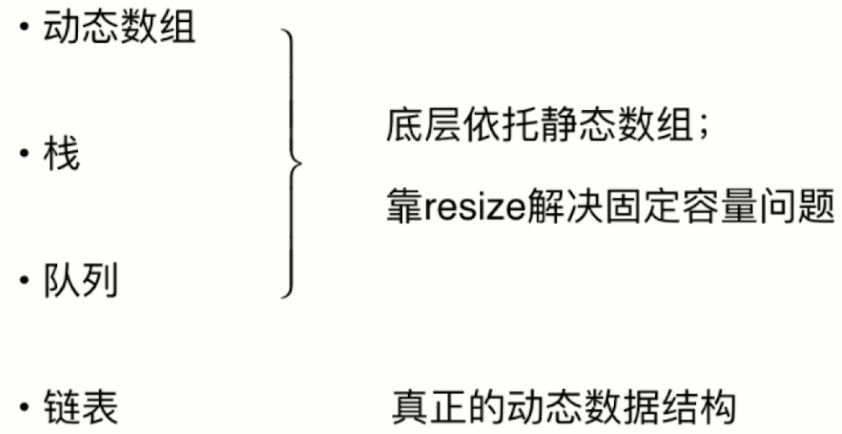
为什么链表很重要?
- 最简单的动态数据结构
- 帮助更深入的理解引用(或者指针)
- 更深入的理解递归
- 辅助组成其他数据结构
链表 Linked List
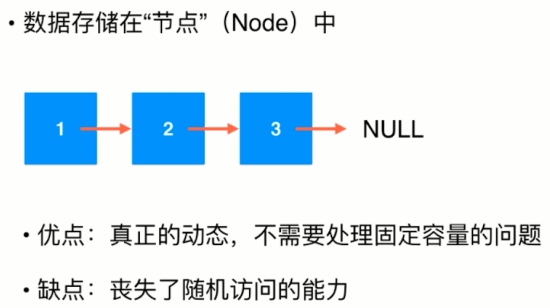
数组和链表的对比

构造函数的写法
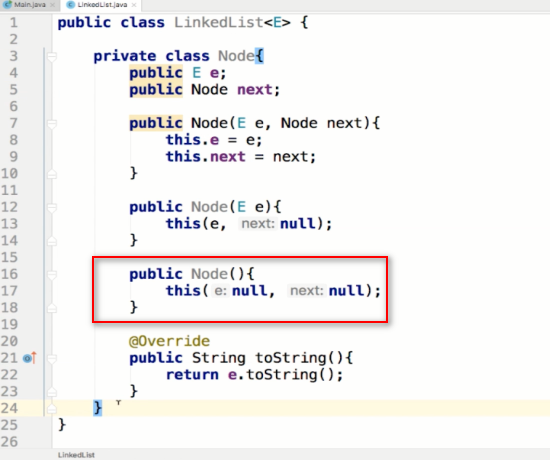
4-2 在链表中添加元素
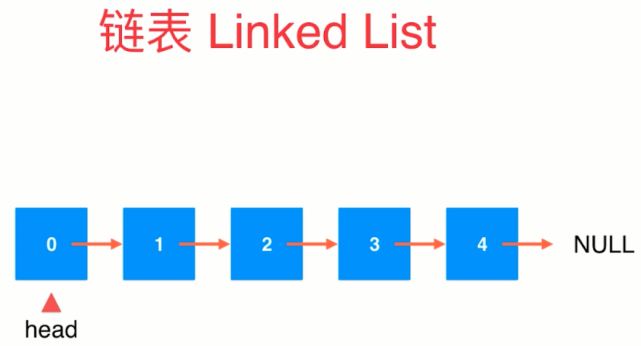
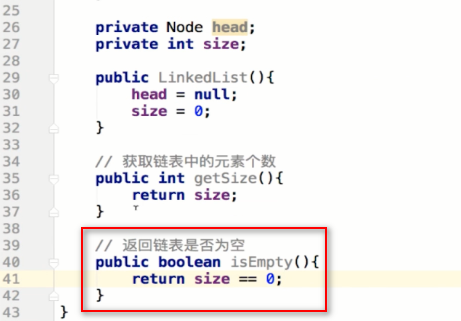

public class LinkedList<E> { private class Node{ public E e; public Node next; public Node(E e, Node next){ this.e = e; this.next = next; } public Node(E e){ this(e, null); } public Node(){ this(null, null); } @Override public String toString(){ return e.toString(); } } private Node head; private int size; public LinkedList(){ head = null; size = 0; } // 获取链表中的元素个数 public int getSize(){ return size; } // 返回链表是否为空 public boolean isEmpty(){ return size == 0; } // 在链表头添加新的元素e public void addFirst(E e){ // Node node = new Node(e); // node.next = head; // head = node; head = new Node(e, head); size ++; } // 在链表的index(0-based)位置添加新的元素e // 在链表中不是一个常用的操作,练习用:) public void add(int index, E e){ if(index < 0 || index > size) throw new IllegalArgumentException("Add failed. Illegal index."); if(index == 0) addFirst(e); else{ Node prev = head; for(int i = 0 ; i < index - 1 ; i ++) prev = prev.next; // Node node = new Node(e); // node.next = prev.next; // prev.next = node; prev.next = new Node(e, prev.next); size ++; } } // 在链表末尾添加新的元素e public void addLast(E e){ add(size, e); } }
在链表头添加元素
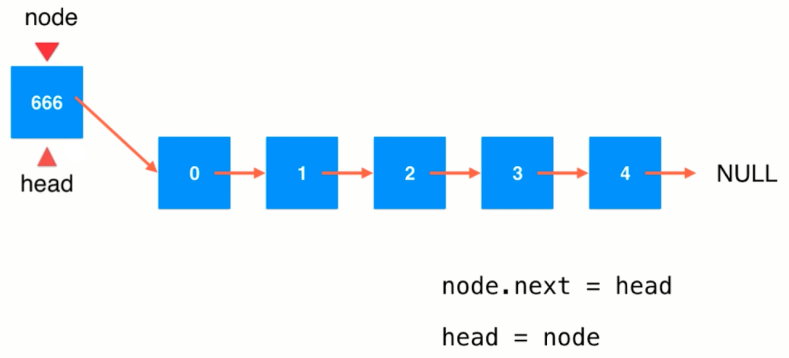
在链表中间添加元素
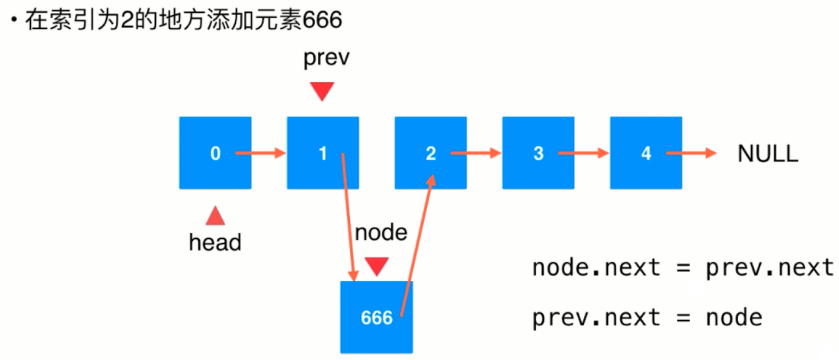
4-3 使用链表的虚拟头结点


public class LinkedList<E> { private class Node{ public E e; public Node next; public Node(E e, Node next){ this.e = e; this.next = next; } public Node(E e){ this(e, null); } public Node(){ this(null, null); } @Override public String toString(){ return e.toString(); } } private Node dummyHead; private int size; public LinkedList(){ dummyHead = new Node(); size = 0; } // 获取链表中的元素个数 public int getSize(){ return size; } // 返回链表是否为空 public boolean isEmpty(){ return size == 0; } // 在链表的index(0-based)位置添加新的元素e // 在链表中不是一个常用的操作,练习用:) public void add(int index, E e){ if(index < 0 || index > size) throw new IllegalArgumentException("Add failed. Illegal index."); Node prev = dummyHead; for(int i = 0 ; i < index ; i ++) prev = prev.next; prev.next = new Node(e, prev.next); size ++; } // 在链表头添加新的元素e public void addFirst(E e){ add(0, e); } // 在链表末尾添加新的元素e public void addLast(E e){ add(size, e); } }
4-4 链表的遍历,查询和修改

public class LinkedList<E> { private class Node{ public E e; public Node next; public Node(E e, Node next){ this.e = e; this.next = next; } public Node(E e){ this(e, null); } public Node(){ this(null, null); } @Override public String toString(){ return e.toString(); } } private Node dummyHead; private int size; public LinkedList(){ dummyHead = new Node(); size = 0; } // 获取链表中的元素个数 public int getSize(){ return size; } // 返回链表是否为空 public boolean isEmpty(){ return size == 0; } // 在链表的index(0-based)位置添加新的元素e // 在链表中不是一个常用的操作,练习用:) public void add(int index, E e){ if(index < 0 || index > size) throw new IllegalArgumentException("Add failed. Illegal index."); Node prev = dummyHead; for(int i = 0 ; i < index ; i ++) prev = prev.next; prev.next = new Node(e, prev.next); size ++; } // 在链表头添加新的元素e public void addFirst(E e){ add(0, e); } // 在链表末尾添加新的元素e public void addLast(E e){ add(size, e); } // 获得链表的第index(0-based)个位置的元素 // 在链表中不是一个常用的操作,练习用:) public E get(int index){ if(index < 0 || index >= size) throw new IllegalArgumentException("Get failed. Illegal index."); Node cur = dummyHead.next; for(int i = 0 ; i < index ; i ++) cur = cur.next; return cur.e; } // 获得链表的第一个元素 public E getFirst(){ return get(0); } // 获得链表的最后一个元素 public E getLast(){ return get(size - 1); } // 修改链表的第index(0-based)个位置的元素为e // 在链表中不是一个常用的操作,练习用:) public void set(int index, E e){ if(index < 0 || index >= size) throw new IllegalArgumentException("Set failed. Illegal index."); Node cur = dummyHead.next; for(int i = 0 ; i < index ; i ++) cur = cur.next; cur.e = e; } // 查找链表中是否有元素e public boolean contains(E e){ Node cur = dummyHead.next; while(cur != null){ if(cur.e.equals(e)) return true; cur = cur.next; } return false; } @Override public String toString(){ StringBuilder res = new StringBuilder(); // Node cur = dummyHead.next; // while(cur != null){ // res.append(cur + "->"); // cur = cur.next; // } for(Node cur = dummyHead.next ; cur != null ; cur = cur.next) res.append(cur + "->"); res.append("NULL"); return res.toString(); } }
04-Query-and-Update-in-LinkedList

public class Main { public static void main(String[] args) { LinkedList<Integer> linkedList = new LinkedList<>(); for(int i = 0 ; i < 5 ; i ++){ linkedList.addFirst(i); System.out.println(linkedList); } linkedList.add(2, 666); System.out.println(linkedList); } }
4-5 从链表中删除元素
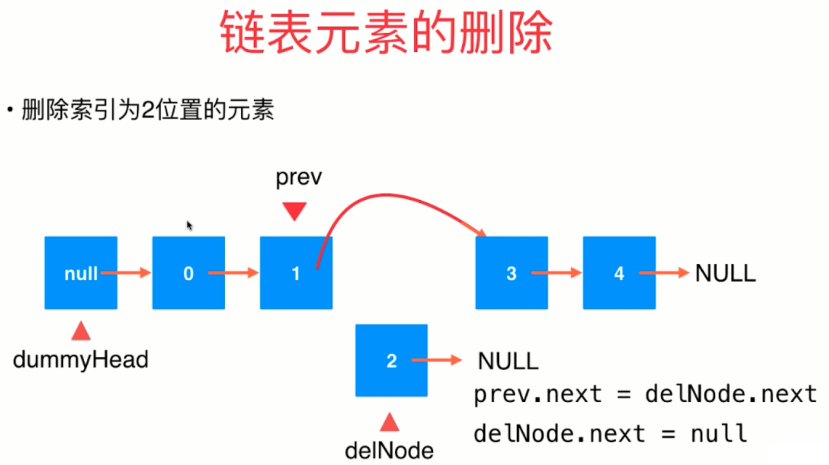

public class LinkedList<E> { private class Node{ public E e; public Node next; public Node(E e, Node next){ this.e = e; this.next = next; } public Node(E e){ this(e, null); } public Node(){ this(null, null); } @Override public String toString(){ return e.toString(); } } private Node dummyHead; private int size; public LinkedList(){ dummyHead = new Node(); size = 0; } // 获取链表中的元素个数 public int getSize(){ return size; } // 返回链表是否为空 public boolean isEmpty(){ return size == 0; } // 在链表的index(0-based)位置添加新的元素e // 在链表中不是一个常用的操作,练习用:) public void add(int index, E e){ if(index < 0 || index > size) throw new IllegalArgumentException("Add failed. Illegal index."); Node prev = dummyHead; for(int i = 0 ; i < index ; i ++) prev = prev.next; prev.next = new Node(e, prev.next); size ++; } // 在链表头添加新的元素e public void addFirst(E e){ add(0, e); } // 在链表末尾添加新的元素e public void addLast(E e){ add(size, e); } // 获得链表的第index(0-based)个位置的元素 // 在链表中不是一个常用的操作,练习用:) public E get(int index){ if(index < 0 || index >= size) throw new IllegalArgumentException("Get failed. Illegal index."); Node cur = dummyHead.next; for(int i = 0 ; i < index ; i ++) cur = cur.next; return cur.e; } // 获得链表的第一个元素 public E getFirst(){ return get(0); } // 获得链表的最后一个元素 public E getLast(){ return get(size - 1); } // 修改链表的第index(0-based)个位置的元素为e // 在链表中不是一个常用的操作,练习用:) public void set(int index, E e){ if(index < 0 || index >= size) throw new IllegalArgumentException("Set failed. Illegal index."); Node cur = dummyHead.next; for(int i = 0 ; i < index ; i ++) cur = cur.next; cur.e = e; } // 查找链表中是否有元素e public boolean contains(E e){ Node cur = dummyHead.next; while(cur != null){ if(cur.e.equals(e)) return true; cur = cur.next; } return false; } // 从链表中删除index(0-based)位置的元素, 返回删除的元素 // 在链表中不是一个常用的操作,练习用:) public E remove(int index){ if(index < 0 || index >= size) throw new IllegalArgumentException("Remove failed. Index is illegal."); Node prev = dummyHead; for(int i = 0 ; i < index ; i ++) prev = prev.next; Node retNode = prev.next; prev.next = retNode.next; retNode.next = null; size --; return retNode.e; } // 从链表中删除第一个元素, 返回删除的元素 public E removeFirst(){ return remove(0); } // 从链表中删除最后一个元素, 返回删除的元素 public E removeLast(){ return remove(size - 1); } // 从链表中删除元素e public void removeElement(E e){ Node prev = dummyHead; while(prev.next != null){ if(prev.next.e.equals(e)) break; prev = prev.next; } if(prev.next != null){ Node delNode = prev.next; prev.next = delNode.next; delNode.next = null; size --; } } @Override public String toString(){ StringBuilder res = new StringBuilder(); Node cur = dummyHead.next; while(cur != null){ res.append(cur + "->"); cur = cur.next; } res.append("NULL"); return res.toString(); } }
05-Remove-Element-in-LinkedList

public class Main { public static void main(String[] args) { LinkedList<Integer> linkedList = new LinkedList<>(); for(int i = 0 ; i < 5 ; i ++){ linkedList.addFirst(i); System.out.println(linkedList); } linkedList.add(2, 666); System.out.println(linkedList); linkedList.remove(2); System.out.println(linkedList); linkedList.removeFirst(); System.out.println(linkedList); linkedList.removeLast(); System.out.println(linkedList); } }
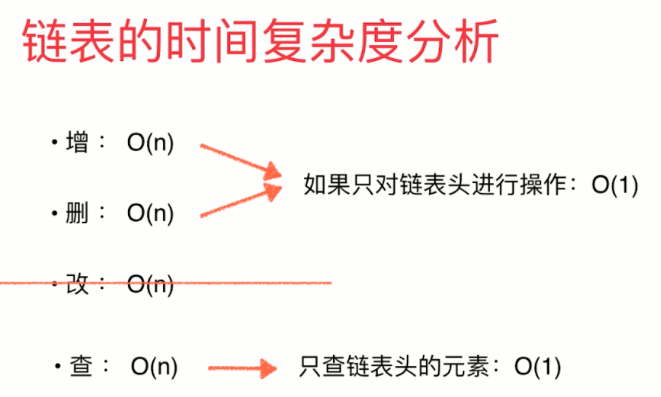
4-6 使用链表实现栈

public interface Stack<E> { int getSize(); boolean isEmpty(); void push(E e); E pop(); E peek(); }
底层封装LinkedList实现的Stack

public class LinkedListStack<E> implements Stack<E> { private LinkedList<E> list; public LinkedListStack(){ list = new LinkedList<>(); } @Override public int getSize(){ return list.getSize(); } @Override public boolean isEmpty(){ return list.isEmpty(); } @Override public void push(E e){ list.addFirst(e); } @Override public E pop(){ return list.removeFirst(); } @Override public E peek(){ return list.getFirst(); } @Override public String toString(){ StringBuilder res = new StringBuilder(); res.append("Stack: top "); res.append(list); return res.toString(); } public static void main(String[] args) { LinkedListStack<Integer> stack = new LinkedListStack<>(); for(int i = 0 ; i < 5 ; i ++){ stack.push(i); System.out.println(stack); } stack.pop(); System.out.println(stack); } }
性能测试对比

import java.util.Random; public class Main { // 测试使用stack运行opCount个push和pop操作所需要的时间,单位:秒 private static double testStack(Stack<Integer> stack, int opCount){ long startTime = System.nanoTime(); Random random = new Random(); for(int i = 0 ; i < opCount ; i ++) stack.push(random.nextInt(Integer.MAX_VALUE)); for(int i = 0 ; i < opCount ; i ++) stack.pop(); long endTime = System.nanoTime(); return (endTime - startTime) / 1000000000.0; } public static void main(String[] args) { int opCount = 100000; ArrayStack<Integer> arrayStack = new ArrayStack<>(); double time1 = testStack(arrayStack, opCount); System.out.println("ArrayStack, time: " + time1 + " s"); LinkedListStack<Integer> linkedListStack = new LinkedListStack<>(); double time2 = testStack(linkedListStack, opCount); System.out.println("LinkedListStack, time: " + time2 + " s"); // 其实这个时间比较很复杂,因为LinkedListStack中包含更多的new操作 } }

结论:时间复杂度的量级差异不太大。
4-7 带有尾指针的链表:使用链表实现队列
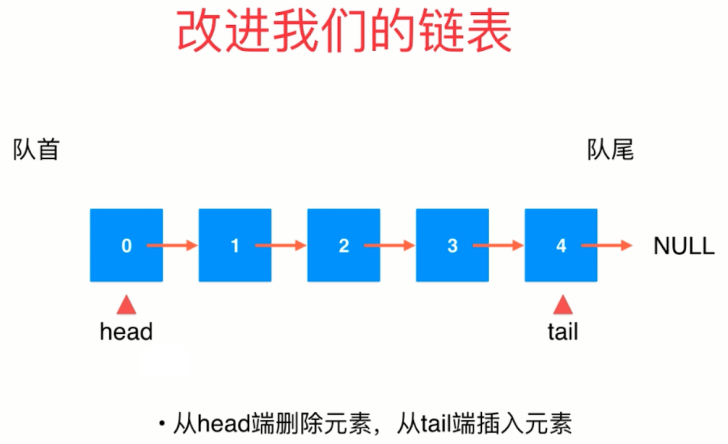

public interface Queue<E> { int getSize(); boolean isEmpty(); void enqueue(E e); E dequeue(); E getFront(); }
LinkedListQueue

public class LinkedListQueue<E> implements Queue<E> { private class Node{ public E e; public Node next; public Node(E e, Node next){ this.e = e; this.next = next; } public Node(E e){ this(e, null); } public Node(){ this(null, null); } @Override public String toString(){ return e.toString(); } } private Node head, tail; private int size; public LinkedListQueue(){ head = null; tail = null; size = 0; } @Override public int getSize(){ return size; } @Override public boolean isEmpty(){ return size == 0; } @Override public void enqueue(E e){ if(tail == null){ tail = new Node(e); head = tail; } else{ tail.next = new Node(e); tail = tail.next; } size ++; } @Override public E dequeue(){ if(isEmpty()) throw new IllegalArgumentException("Cannot dequeue from an empty queue."); Node retNode = head; head = head.next; retNode.next = null; if(head == null) tail = null; size --; return retNode.e; } @Override public E getFront(){ if(isEmpty()) throw new IllegalArgumentException("Queue is empty."); return head.e; } @Override public String toString(){ StringBuilder res = new StringBuilder(); res.append("Queue: front "); Node cur = head; while(cur != null) { res.append(cur + "->"); cur = cur.next; } res.append("NULL tail"); return res.toString(); } public static void main(String[] args){ LinkedListQueue<Integer> queue = new LinkedListQueue<>(); for(int i = 0 ; i < 10 ; i ++){ queue.enqueue(i); System.out.println(queue); if(i % 3 == 2){ queue.dequeue(); System.out.println(queue); } } } }
性能测试对比

import java.util.Random; public class Main { // 测试使用q运行opCount个enqueueu和dequeue操作所需要的时间,单位:秒 private static double testQueue(Queue<Integer> q, int opCount){ long startTime = System.nanoTime(); Random random = new Random(); for(int i = 0 ; i < opCount ; i ++) q.enqueue(random.nextInt(Integer.MAX_VALUE)); for(int i = 0 ; i < opCount ; i ++) q.dequeue(); long endTime = System.nanoTime(); return (endTime - startTime) / 1000000000.0; } public static void main(String[] args) { int opCount = 100000; ArrayQueue<Integer> arrayQueue = new ArrayQueue<>(); double time1 = testQueue(arrayQueue, opCount); System.out.println("ArrayQueue, time: " + time1 + " s"); LoopQueue<Integer> loopQueue = new LoopQueue<>(); double time2 = testQueue(loopQueue, opCount); System.out.println("LoopQueue, time: " + time2 + " s"); LinkedListQueue<Integer> linkedListQueue = new LinkedListQueue<>(); double time3 = testQueue(linkedListQueue, opCount); System.out.println("LinkedListQueue, time: " + time3 + " s"); } }

部分内容来自于学习编程期间收集于网络的免费分享资源和工作后购买的付费内容。
如需获取教程配套的资源文件和一对一专属答疑支持,请加vx:kangmf24联系作者。






